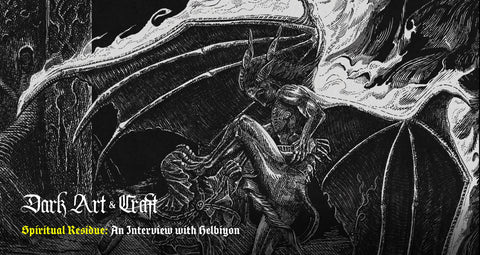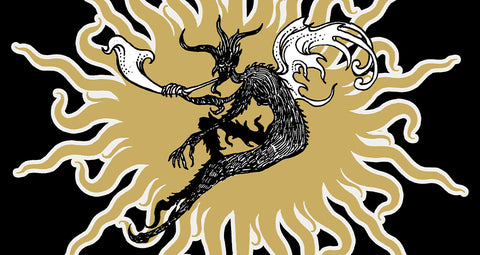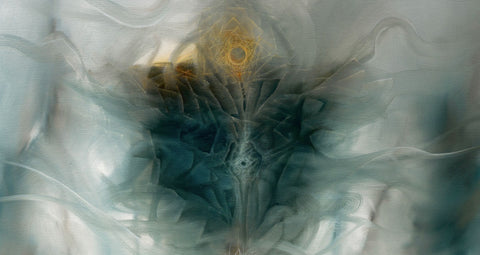The UK has always been on my must-visit list. Growing up in Southern California the notion of “historic” came from the white colonized perspective, meaning buildings created in the nineteenth century. The prospect of seeing towering fabricated behemoths that have seen anywhere from a thousand to several hundred years standing prominently amongst the contemporary cityscape was something I could barely conceive.
I often travel to see the originating locations of urban lore and legends. I'm sure a lot of you reading this can relate to it, it's definitely in our niche. "Our," being the target audience of dark art lovers who frequent this blog and relish in the artwork we post on Instagram. Every time I hear the word "haunted" my ears perk up and I insert myself into the conversation, nearly shouting "WHERE IS THIS PLACE" as soon as I can. This yearning need to hunt the haunts has taken us some strange places including (but certainly not limited to): Lalaurie Mansion of New Orleans, the Whaley House of San Diego, Abandoned Insane Asylum of Waltham, The Ridges of Athens, Thurber House of Columbus, Lizzie Borden House of New Bedford, Ohio State Reformatory of Mansfield...well, you get the picture.
This article ended up being significantly longer than I had anticipated, so I whittled down a lengthy list to covering three amazingly haunted castles throughout the United Kingdom.
Stop One: The Tower of London

The first order of business after a red eye from New York to London was of course coffee, and then straight to the Tower of London. You know, you think you would be prepared to see a gigantic castle just coexisting within contemporary London’s cityscape, but it doesn’t. There’s something so awe inspiring to see a WeWork so nonchalantly across the street, seeing people running recreationally or shuffling past in a hurry to catch the Underground trains. It’s surreal and I hope you all get to experience this time warp of a cluster fuck.

The Tower of London first began construction under William the Conqueror in 1078. It took approximately 250 years after his time to finish construction of the beautiful complex. It was at the tail end of this construction that the first believed siting occurred. During the 13th century, the angry ghost of Thomas Beckett began messing with new construction and causing destruction. Afraid that Beckett would really make things difficult (and knowing that his father's men had murdered him), King Henry III erected a chapel to him, and the archbishop was never seen again.

We could probably write a book on the horrifying and haunting history of this building but alas we’re not trying to do that so we’ll just cover three specific locations that can’t be missed.

The White Tower is the oldest portion of the castle, and definitely where a majority of the torture occurred. For the first few centuries, it was actually used primarily as a royal residence, but transitioned to a building of incarceration in the fifteenth century. A lot of the experiences in this tower are not attributed to any particular entity, but general sensations that are incredibly unsettling: strong perfume odors at the entrance of St. John’s Chapel, a feeling of crushing anxiety when in the room when in the presence of Henry VIII’s armor are the most common paranormal experiences. One of the greatest mysteries was laid to rest in this tower as well. In the seventeenth century, the bones of two young boys believed to be the Princes in the Tower were found. Finally. After “disappearing” (cough MURDERED) in the late fifteenth century. While their bones reside in the White Tower, their spirits still haunt the halls of the Bloody Tower to this day.

I’m not trying to go to ham on history, but to fully understand the ghosts of the two princes, we have to go back to the fifteenth century. Also, as someone who didn’t study much European history in high school (or ever?), I cannot believe the intense drama of it all. Richard III seized the throne after he imprisoned both of his young nephews in the Tower of London. They were never seen again. It doesn’t take much to put two and two together, but clearly the twelve and nine-year-olds were murdered so as to not get in the way of any power struggle. The Princes of the Tower are one of the most active ghosts of the Bloody Tower.

The Tower Green was where the privileged, upper echelon of society was executed, such as Henry VIII’s queens. In fact, one of the most active ghosts within this region is none other than Anne Boleyn. Boleyn has been seen wandering the hallways, and even leading processions throughout the tower, leading the ghostly crowd to the site of her final resting place. In 1864, a guard was confronted by her headless body and after stabbing the vision with his bayonet she disappeared. The final ghost we’ll be covering for the Tower of London is probably the most fucked up. In the sixteenth century, the Countess of Salisbury refused her execution, causing for a especially bloody and violent death by the executioner. It is sad that on the anniversary of her death, you can see a reenactment of her death, being chased by an ax-bearing executioner, and being slaughtered.
Stop Two: Carlisle Castle

On the way north, the next stop was the Carlisle Castle. Initially, what drew me to the castle was the legend that this was the site of King Arthur’s Camelot. I believe several locations have this rumor attached to them, but that’s neither here nor there. What I can tell you officially though is it’s also built on top of a first century Roman fort named Luguvalium. Situated in Northern England means that Carlisle Castle saw many, many bloody battles between the English and the Scottish. Construction began by our dude William the Conquerer in the late eleventh century and continued with Henry I in the twelfth century as a protective measure against the Scottish. It holds the title of the most besieged place in the British Isles, meaning this place has seen a ton of blood, and you know that means ghosts.

And true to its bloody history, the castle is notoriously one of the most haunted locations in England. The place is positively crawling with what are described as friendly ghosts just going about their day. They are frozen in time repeating the lives they left behind. Some examples of these friendly spirits include: two medieval soldiers going about their day at the top of the keep, an old caretaker wandering about the inner keep, and a yeoman running in front of the cellblock on what looks like his way to military headquarters.

A playful ghost in the Military Museum likes to play tricks when there are few visitors and has been known to push and pull people up and down the stairs, in teasing way. In general, the Military Museum is crawling with activity. The whole space has been said to be a hub of double takes and an eerie feeling of being watched.

The highlight of the ghost histories of this particular castle is the Scottish woman. In 1820 a woman was excavated during construction. She had been laying within the Captains Tower staircase with a child in her hands. From her tartan garb, they were able to figure out that she was from the Elizabethan era. A few years later, she was seen haunting the halls. A soldier attempted to stab her with his bayonet on confrontation, and despite her disappearing, he died later that night of fright. It is said that she still haunts the halls to this very day, and often times alarms going off are blamed on her presence.
Stop Three: Edinburgh Castle

The final castle for today’s purposes will be the one and the only Edinburgh Castle. Normally a hub of tourist activity, we found ourselves in Edinburgh for the Fringe Festival, a weekend-long arts festival boasting of music, comedy and plays. This meant that Edinburgh’s streets were dotted with humanity, shoulder to shoulder writhing up and down the cobblestone streets. Which if I’m honest is my waking nightmare. Despite the incredible amount of people, we experienced some really unsettling experiences throughout the Castle. Before we get into those, a brief historical overview.

The actual construction of Edinburgh Castle seems to be a little less clear with Edinburgh Castle, but we do have some early clues. The Welsh epic poem Y Godaddin references Din Eldiyn, or the stronghold of Edinburgh, believed to be Edinburgh Castle. The poem is dated around the seventh century. This stronghold of Scotland has seen a lot of violence over the last one thousand years, mostly stemming from the tumultuous relationship of the Scottish and English. The castle has changed hands between the Scottish and English during medieval times like a game of very violent, very bloody hot potato. Countless people have been imprisoned here, met their deaths here, worshipped here, needless to say such is the stuff that hauntings are made from. Edinburgh is the most haunted city in the UK, and Edinburgh Castle is considered the epicenter for paranormal activity.

Edinburgh, while relatively small, was also the home to one of the highest persecutions of witches. Over 3800 were suspected of being witches and consequentially executed by hanging, drowning, or burning at the stake. The first Scottish witch trails began in the sixteenth century, and reached peak persecution and execution within the seventeenth and eighteenth centuries. One of the accused witches still haunts the halls of Edinburgh. Lady of Glamis was accused of witchcraft in the sixteenth century, and was sentenced to death. She waited out her days in the dungeon of the castle, and after being burned at the stake (with her son watching no less), she refused to leave. She continues to walk around the battlements, and the sound of constructing her execution platform continues to this very day.

Another dungeon dweller also refuses to leave. This one particularly desperate inmate decided to hide himself within the prison’s…uh…poop pile, in hopes of escaping when it was removed from the Castle. In a sense, he was successful. However, he didn’t realize how the excrement would be disposed of, and when he did it was much, much too late. The guards dumped all of the contents down the steep rocky slope of Castle Rock, and that is where he met his end. He still continues to troll the grounds today, and it’s said if you smell dung or feel someone trying to push you off the battlements, it’s him.

The street leading up to the castle is called the Royal Mile, a stretch that is rife with paranormal activity. Under the streets, are a series of underground caverns, and one day a bag piper was tasked with playing his pipes throughout the underground maze, so that those from above could have a better understanding of what the structure was like beneath their feet. He began well enough, and then abruptly he stopped. He disappeared without a trace, and it is said he continues to play his pipes in the afterlife, sometimes one can hear him inside the castle, sometimes echoing around the Royal Mile.

A scientific study was conducted at the Castle in 2001 by Dr. Richard Wiseman to determine if there was indeed paranormal activity or it was just the manifestation of desired activity. He hand selected participants who had no knowledge of the haunting hot spots and ghosts. Hundreds of people from all over the world were placed all throughout the castle: in some of the darkest and scariest locations rife with haunting documentations, and others were placed in areas that have no paranormal sightings. Some of the experiences recorded are absolutely chilling. One of my favorites is from the South Bridge vaults, where one woman heard a heavy breathing from the corner, that got louder and louder and manifested into a light. This all transpired within moments of being within the enclosure. Despite any prior knowledge, all people who were placed within paranormal hubs experienced drops in temperature, the feeling of being watched, shadowy figures, getting touched, and even one person said they got burned by something. “The events that have been taking place over the last 10 days are more extreme than we expected,” Dr. Wiseman said.
So there you have it, some of the haunting stories of some of UK’s landmarks. It took me three pages to go through these three locations, and these three pages could’ve easily been much, much longer. We’re excited to be adding some travel destinations and lore to our blog sections, if you ever have any suggestions, feel free to shoot me a message at: darkartmarketing@gmail.com .
About the Author:
Steph is one of the co-owners of Dark Art & Craft, and when she’s not interviewing artists and developing some new ideas for events and brand development over here, she’s over at @sigilmarketing doing digital marketing & content consulting for small creative businesses.




